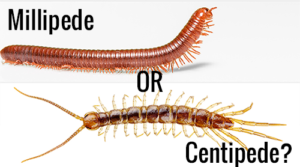Back to: ZOOLOGY 200 Level
WELCOME TO CLASS
Today, we’re going to look at two fascinating arthropods you’ve probably seen crawling around during the rainy season or under moist logs—millipedes and centipedes. Though they may look similar at first glance, these creatures are quite different in structure, behaviour, and function. Let’s examine their unique characteristics together.
Millipedes And Centipedes
General characteristics
Millipedes and centipedes belong to a group of arthropods called myriapods, which means “many legs”. Both have segmented bodies and numerous legs, but that’s where most of their similarities end. Their body structure, movement, diet, and defence mechanisms all differ greatly.

Body structure and movement
Millipedes have cylindrical, rounded bodies with two pairs of legs per body segment. This gives them a slow, steady movement. Centipedes, on the other hand, have flatter bodies with one pair of legs per segment, which allows them to move quickly and often with a jerky motion.
You can easily tell them apart by how they walk. Millipedes appear to glide slowly like a train, while centipedes dart around rapidly like they’re on a mission.
Feeding habits
Millipedes are herbivores and detritivores—they feed mostly on decaying plant matter, which helps recycle nutrients back into the soil. This makes them very important for agriculture and composting.
Centipedes are carnivores. They use their sharp, poison-tipped claws (called forcipules) to paralyse and kill small insects and other invertebrates. Although they can bite humans if provoked, most centipede bites are not harmful.

Defence and survival
When threatened, millipedes curl up into a tight spiral to protect their soft undersides. Some also release foul-smelling chemicals to deter predators. Centipedes, however, prefer to run quickly or fight back using their venomous claws.
Habitat and ecological role
Both animals prefer moist, dark environments like leaf litter, under stones, or in the soil. Millipedes help in decomposing organic material, while centipedes help control pest populations by preying on insects.
Summary
- Millipedes and centipedes are myriapods with segmented bodies and many legs.
- Millipedes have two pairs of legs per segment, are herbivores, and move slowly.
- Centipedes have one pair of legs per segment, are carnivores, and move quickly.
- Millipedes defend themselves by curling up, while centipedes use venomous claws.
- Both play important roles in ecosystems—millipedes in decomposition, centipedes in pest control.
Evaluation
- Mention two differences between millipedes and centipedes.
- What is the main food source of millipedes?
- How do centipedes capture their prey?
- What is the ecological importance of both animals?
Keep this energy going—you’re mastering the animal kingdom one step at a time. Remember, every new fact you learn is another tool for understanding the world around you. Afrilearn is right here with you—onwards to the next adventure!
